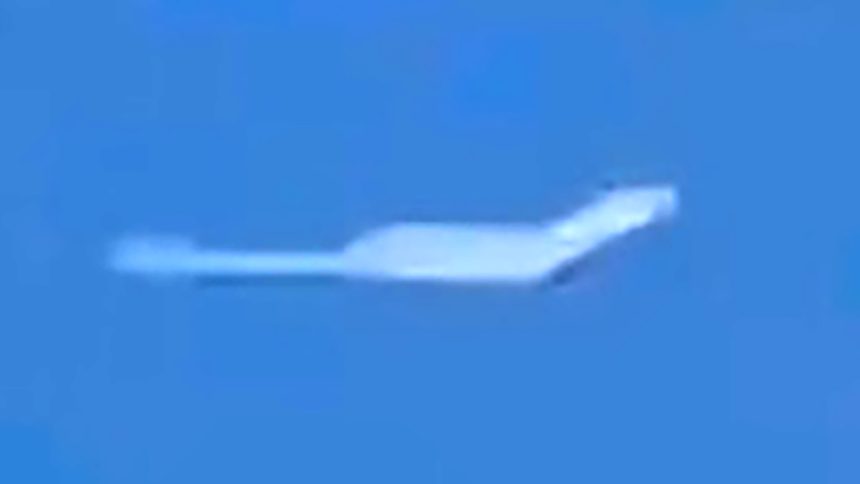A video appears to show the Northrop Grumman B-21 Raider bomber during a test flight over California.
The B-21 Raider is carrying out test flights out of Edwards Air Force Base, in California, where the aircraft landed at the end of its first flight from Air Force Plant 42 in Palmdale on Nov.10, 2023.
Although the U.S. Air Force has been tight-lipped about the status of the secretive aircraft since then, with no further details or photos of the bomber’s first flight and arrival at Edwards AFB, released, it acknowledged that the flight test campaign is proceeding after a possible safety chase aircraft was spotted on flight tracking websites with the callsign “Raider”. A spokesperson confirmed, in fact, that the bomber flew on Jan. 17, 2024, adding that the Air Force would not provide further details about the test program nor the number of flights the aircraft has flown.
A flight test was rumored to have taken place on Mar. 28, 2024.
Rumors have it that the B-21 flew today. This would be the “official” first test flight if it’s true. Chase plane is up. https://t.co/XX32u4Xfix
— In The Air (@NewsAmarillo) March 28, 2024
Another one possibly took place on Apr. 1.
Some normal but interesting aircrafts our of Edwards today, along with a Beech200 sporting the “Raider09” callsign. It’s possible the B-21 is back flying today for further testing. pic.twitter.com/Jivs2EFpfi
— Colin Smith (@ColinSm39479908) April 1, 2024
The stealth bomber, which was named “Cerberus”, took to the skies again on Apr. 4, 2024, as a video posted on X and shot with a smartphone seems to show. The clip, that appears to be genuine, shows the B-21 Raider flying at high altitude, apparently with the landing gear retracted (whereas, during the first flight, as always happens with all aircraft, the gear remained down for the flight), escorted by a chase aircraft.
The quality and distance of the subject make it impossible for us to assess whether the Raider is still equipped with the “trailing cone” (observed also on other types), usually a nylon cable with a stabilizing cone deployed in flight, generally 1 to 1.5 times the wing span length, or about 50 metres, behind the aircraft to measure the ambient atmospheric pressure (static pressure) precisely, in the “free-stream air-flow” outside the disrupted air-flow generated by the aircraft.
Take a look by yourself here.
stabilized and slowed down… #b21raider https://t.co/xY0Dd7jhyW pic.twitter.com/KQB2TYgrH6
— Ruben Hofs (@rubenhofs) April 5, 2024
Test campaign in full swing
The aircraft is currently undergoing a robust flight test campaign executed by the B-21 Combined Test Force at Edwards Air Force Base, California, after the first flight from Palmdale in November 2023 and the Low-Rate Initial Production contract in January 2024. Northrop Grumman added in the press release that the program is continuing to meet all DoD technical, schedule and affordability requirements on its path to operational capability.
Developed with the next generation of stealth technology, advanced networking capabilities and open systems architecture, the B-21 Raider will serve as the backbone of America’s bomber fleet, with 100 bombers on order to replace the B-2A Spirit and B-1B Lancer bombers. The B-21 might take an even bigger role in future, as the head of U.S. Strategic Command expressed interest in acquiring more than the planned 100 aircraft.
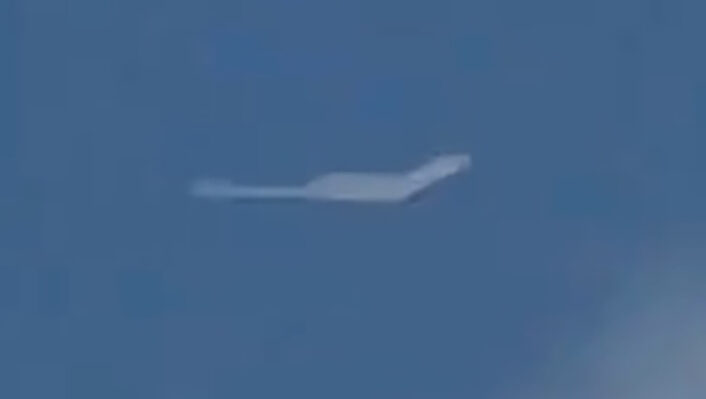
Here below you can find a recap with all the details about the B-21 Raider we have published in the latest articles.
The B-21 Raider
Destined to replace the B-1 and B-2 fleets, the B-21 Raider, the first major strategic bomber introduced in 34 years, was officially unveiled on Dec. 2, 2022, during a rollout ceremony at Northrop Grumman’s Palmdale, California facility gathering political dignitaries, defense department officials, Air Force officers, enlisted personnel and a large group of employees responsible for the B-21 Raider program.
There is a subtle, and quietly sinister shift in the appearance of the B-21 Raider from its predecessor the B-2 Spirit. The B-21’s oddly formed canopy speaks to changes made from experiences with the B-2 Spirit. The B-21 is visually and dimensionally smaller than the B-2, leaving an initially less menacing impression due to its size. But the smooth, animal-like contours and strangely non-metallic appearance of its gray surface give the more sophisticated observer a sense of quiet lethality and lurking advancement that the rollout didn’t reveal and, in fact, wilfully concealed.
Here’s the updated list of the details we noticed, almost live, as the aircraft was being unveiled:
- Overall shape is similar to the one of the B-2 but the B-21 is probably smaller in size (not as small as I was expecting)
- We weren’t allowed any side or planform views. While the Raider is believed to be a flying wing like the B-2, the NG photo below and some barely visible shadows *might* mean the aircraft has a sort of cranked arrow wing similar to the one of the X-47B. This is something we’ll discover in the future.
- B-21 leading edge shows different design concept than the B-2
- We can’t completely assess the shape of the “hawk’s-beak” profile, although it seems similar to what shown in the latest rendering and less pronounced than the one of the Spirit.
- The B-21 features different inlets config (and blended conformal engine nacelles we can’t see from the front angle). The hd version of the front photo released by the U.S. Air Force reveal a splitter plate in the inlet.
- The B-21 has a two-wheel MLG (Main Landing Gear)
- MLG and Nose Gear doors: MLG doors are not trapezoidal but show serrated edges whereas the nosegear door is serrated and not attached to the gear leg but on the right side of the bay.
- The Raider has a new four-pieces windscreen, like the Spirit, but with a very different shape for the two lateral windows. The side windows appear to be arched and narrower than the ones in the front (about half the height).
- The color seems to be a light gray (like the RQ-180)
- There’s a small logo in front of the nose gear wheel bay that appears to be the stylized Northrop Grumman Flight test badge that also appears on the X-47B right wing.
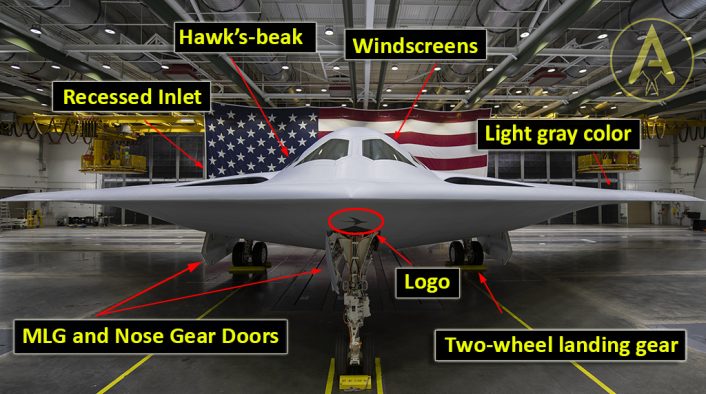
On Sept. 12, 2023, three new photos of the B-21 Raider sixth generation stealth bomber were released during the 2023 Air, Space & Cyber Conference. Compared to the photos released in March 2023, the bomber appeared in a much more advanced state of completion as engine runs are already in progress as part of its ground test program at Northrop Grumman’s Palmdale facility.
The new photo allowed for a rough estimate of the dimensions of the B-21 by using the personnel under the bomber as reference. Comparing them with the average height of people in the US, the B-21 appears to have a wingspan of about 41.5 m (136 ft) and a height of 6.6 m (20 ft), which means it is narrower (135 ft vs 172 ft) and higher (20 ft vs 17 ft) than the B-2 Spirit.
In all the photos we can see two large trapezoidal arrays on the sides of the nose landing gears which, while they have smaller dimensions, are highly reminiscent of the AN/APQ-181 radar arrays found on the B-2A. The different dimensions are not an issue, as the arrays of the B-2A were designed for a mid-1980s radar technology, while the technology used on the B-21 benefits from the latest miniaturized radar technology.
A dozen of black trapezoidal patches can be seen on the underside of the aircraft, four just below the nose and four on each side aligned with the engine air inlet. While the photos don’t show them clearly, we can assume they could be either air data sensors or fiducial markers for flight testing. Below the cockpit windows we can see two sets of dynamic and static air data ports similar to the ones found on the B-2A.
A large orange air data probe has also been installed on the side of the nose landing gear. We can clearly see that the probe is angled downwards, which led some to suggesting the airplane may fly with a slight pitch-up attitude.
The new photos show for the first time the control surfaces of the B-21 in a not neutral position. Four sets of surfaces can be seen, three on the outboard side and one on the inboard side of the wing. Judging by the positions and comparing with the B-2A, we can assume that the outermost surfaces are split rudders, while the remaining ones are elevons. On the B-2A, since it has no vertical fin, the split rudders and the elevons are used to control the aircraft rotation along the vertical/yaw axis, whereas pitch and roll are controlled by means of (mid and inboard) elevons.
The side views show even better how the engine section has been blended in the airframe making them as flush as possible with the wing’s surface, compared to the B-2A. As we saw also in the previously released photos, the engine inlets are buried in the airframe to maintain a low Radar Cross Section, as those are usually one of the weakest points for low observability. A black patch can also be seen in the rear of the engine area, which could possibly be an extension of the thermal protection used for the exhaust.
Judging by the markings on top of the aircraft, the air-to-air refueling receptacle has now been added. Other markings that can be seen on top are the serial number in the rear (same position of the B-2A), the insignia of the Air Force Global Strike Command, 412th Test Wing and Air Force Materiel Command, and the markings for the ejection seat warnings and the ejection hatches. The “No Step” and other standard markings have also been applied. The 412th Test Wing insignia on the top of the aircraft is complemented by the “ED” markings on the main landing gear doors.
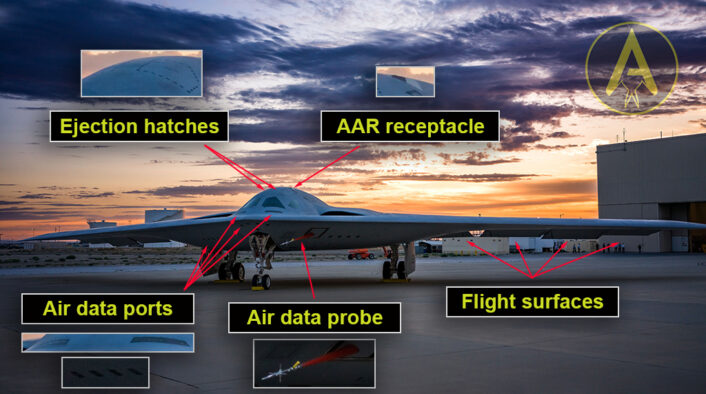
At 6:51 a.m on Nov. 10, 2023, local time, the B-21 Raider made its first flight from Palmdale to Edwards Air Force Base. As time goes by more sightings of the historic flight of “Cerberus” are being published online. Most noteworthy are the high-quality images of the aircraft’s underbelly photographed by fellow plane spotters that were waiting underneath the flightpath. This has allowed for an in-depth analysis of the Raider’s lesser-known details.
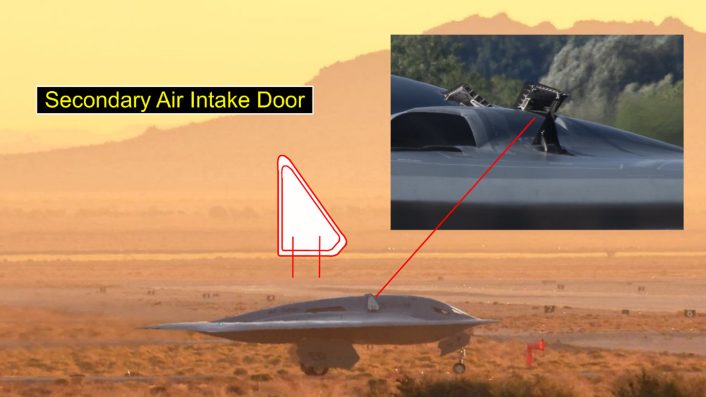
The sideview of the B-21 taxiing under its own power seems to confirm that the aircraft has one secondary air intake door on top of each nacelle. On the B-2, the semi recessed engines have secondary intake doors that open during take off to provide adequate airflow. While the B-2 has two doors per nacelle for its four engines, the B-21 only appears to have a total of two doors.
While it is possible that the airduct splits into two from a single opening to cater for two engine, it is more likely that the single intake door signifies that there is only one engine in each nacelle. While more evidence should be overviewed before making a sound conclusion, it seems ever so likely that the B-21 is a twin-engine bomber.
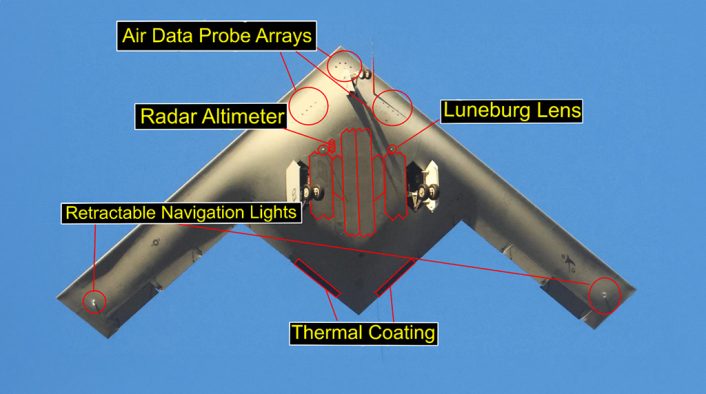
Some key features on the B-21’s underside could be noted after the first flight:
What some initially thought to be the radar reflectors located on either end of the flying wing seems to be retractable navigation lights, similar to what can be found on the B-2. While the outboard navigation lights stay deployed in normal operating conditions, they protrude out of the wing and thus impact the total radar cross section of a stealth aircraft. Thus, it is common practice for the B-2 to retract its navigation lights when undergoing a combat sortie. The same type of retractable navigation lights is expected to be the protrusions shown on either end of the B-21’s wing.
The real radar reflectors, or Luneburg Lenses, are pictured here installed between the landing gears. As a stealth aircraft will not normally appear on radar, they tend to fly with radar reflectors on unless the need for low detection is required. Furthermore, on a prototype aircraft as this, it is rare to see one flying without radar reflectors as the true radar return tends to be a closely guarded secret.
Due to the aircraft’s low observable nature, its pitot tubes and static probes are also of a non-conventional shape. Nearly identical to the setup found on the B-2, the B-21 also utilises three sets of four air data probes located on the nose and cheek of the aircraft. While any aircraft needs a set of pitot tube and static ports to measure its airspeed, altitude, and vertical speed, they tend to stick out into the free-stream for accurate measurements. However, having a conventional pitot static tube will be detrimental to a stealth aircraft’s radar return. Thus, the B-2 utilises a set of flush mounted static ports and data correction to imitate the role of a conventional pitot tube. Due to the air data probes’ location being at an angle to the local airflow, there tends to be a few arrays of the same sensors to account for inaccuracies in measurement. In this case, the B-21 seems to have a near identical setup on its air data ports as the B-2’s.
Generally speaking, as observed on other types, the “trailing cone” is usually a nylon cable with a stabilizing cone deployed in flight, generally 1 to 1.5 times the wing span length, or about 50 metres, behind the aircraft to measure the ambient atmospheric pressure (static pressure) precisely, in the “free-stream air-flow” outside the disrupted air-flow generated by the aircraft – a key parameter for the pilots.
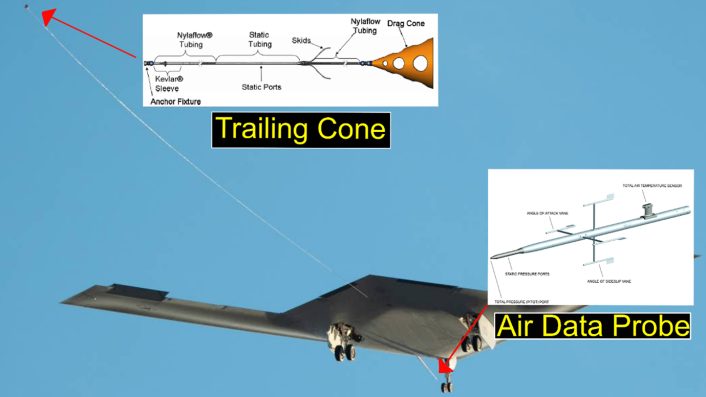
Much like that on the B-2, a darker shaded strip can be seen extending to the underside of the Raider’s rear end. This appears to be a thermal coating applied to the area in direct contact with the engine exhaust. Usually made from a carbon fibre reinforced polymer, thermal coatings like this ensure that the engine exhaust is cooled down to reduce IR signature. It should be noted that Very Low Observable technology (or “stealth”) not only refers to low detection from radar, but also in other spectrums of including both visible and infrared. Hence, an effort is made to reduce the B-21’s detection in those arenas through a grey paint scheme and thermal coatings.
The most intriguing detail found would be the possibility of a second set of internal weapons bays.
With the main landing gears seeming to fold forwards, the panel line between the main landing gear doors and the central weapons bays raises suspicion for another weapons bay. While the central weapons bay has two sets of doors that swing open, the secondary weapons bays appear to open up with a single door. As evident from the annotated picture, the two set of secondary weapons bays would be smaller in width and length than the main bay. It can be speculated that there will be space for self defence features such as decoys, air-launched drones, or even air-to-air missiles. It should be noted that the USAF page on the B-21’s capabilities mentions that the platform will “…accommodate manned or unmanned operations”. There is a possibility for the drone decoys to be launched from the smaller weapons bays to allow for the main weapons bay to be solely dedicated for munitions delivery. The USAF using ADM-160 Miniature Air Launched Decoy (MALD) on F-16s and B-52s, it is thought that the MALD could be integrated to the B-21 as well. Most recently AGM-160Bs were seen employed in Ukraine acting as decoys for Storm Shadow cruise missiles.
There are also chances the doors are used for something else: someone suggested they might be used for maintenance purposes, for instance to facilitate the access to the engines.
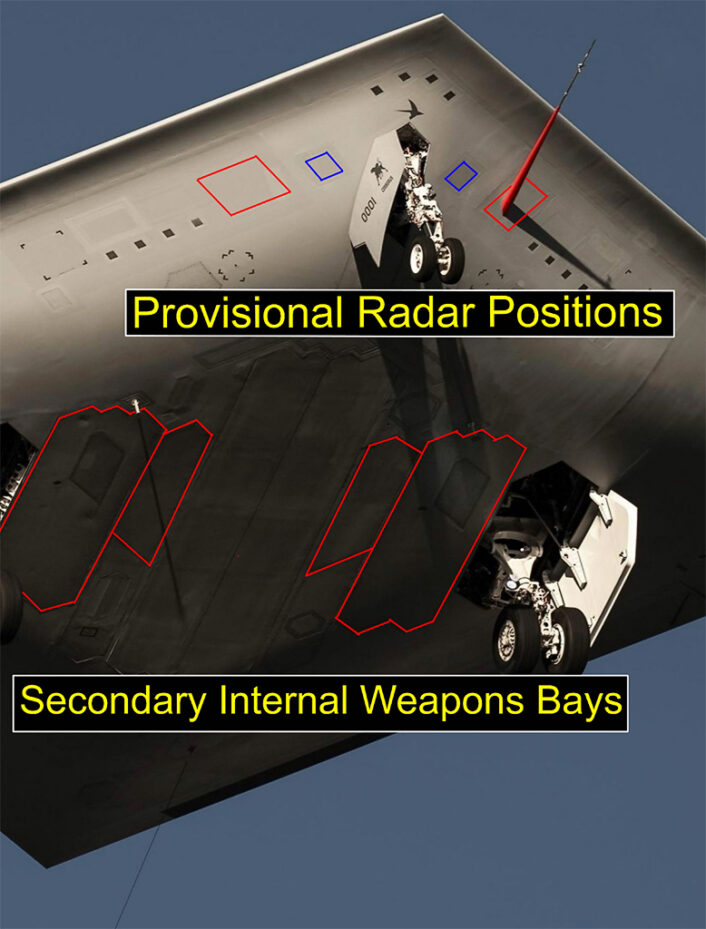
While the prototype aircraft is not expected to carry an internal radar, a rough estimate of the size and position of the radar can be deduced from the panel gaps. With the B-2 utilising two AN/APQ-181 radars below the leading edge on its cheeks, the B-21 is likely to have its radar, if any, to be in a similar position. The AN/APQ-181s on the B-2 provided 21 separate modes for terrain-following and terrain-avoidance, navigation system updates, target search, location, identification and acquisition and weapon delivery.
With the development of active electronically scanned array (AESA) technology, the radars onboard the B-21 will have s much smaller volume than the previous generation that can be found on the B-2. Therefore, it seems fairly reasonable for the B-21 to carry its own radar.
Based on the panel lines photographed, it appears that a two-radar setup like that on the B-2 will be decided, either having the antennas placed inside the blue or red boxes shown above. Although, considering the size of modern AESA radars on fighter platforms, it seems more likely that the radars will be located in the red boxes due to size constraints. One of the red panels marked above is taken up by an air data probe at the moment, but this is for sensor calibration and will only be present on the prototype aircraft. Hence, it is a reasonable assumption that the current space occupied by the air data probe mount is space for the later instalment of a low probability of intercept radar on production variants.
Finally, before you freak out about sensitive details being disclosed and things like that, please remember the flight was somewhat “announced” (i.e. several spotters knew it would happen on Nov. 10 after being cancelled on Nov. 9) and happened in plain daylight. So there was nothing to hide. Moreover, as often highlighted by Northrop Grumman, the B-21’s most important features are inside the aircraft and can’t be seen from the outside…

